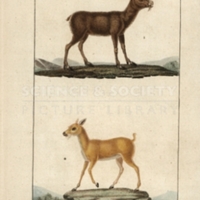Musk
Dublin Core
Title
Subject
Description
Musk oil, obtained from the musk deer, native to the Himalaya area (including India and China) was shipped to Europe through Islamic lands during the Renaissance.
Scents of animal origin, including musk and two other ingredients made from animal products mentioned in Ms. Fr. 640 - civet and ambergris - were very popular during the Renaissance for their powerful olfactory properties.
Source
Fol. 163r – “Perfumer”
They readily put half of amber & half of musk & very little civet, because amber always overtakes the principal scent of musk.
To spare the amber, they readily put a little musk in the white layers, which gives a more forceful scent. But to remove or hide the blackness of the musk, they put in a bit of wheat starch from England, which is perfectly white.
To perfume with white amber in the Portuguese fashion, take a huchau of amber, well broken up. And having put in a small silver bowl a spoonful of flower oil, or lacking that, ben oil, that is to say, a silver spoon that one uses at the table, put in your ambergris & place all on a low fire, and it will melt quickly if your amber is good, & it will remain there without lumps. Once all melted, put in the size of a pine nut of civet, & make it melt, & mix it well together. Next, take your gloves, well-cleaned & well-dried, & dipping the tip of your finger very lightly on the edge of the oil, spread it on the glove, little by little & with patience, & rub the glove between your hands, & trace the fingers & the stitches, one after the other. And leave it to dry. Next, trace again as before until the amber is all laid down.
Contributor
Alan Davidson, "Musk," in The Oxford Companion to Food, ed. Tom Jaine (Oxford University Press, 2014), https://www-oxfordreference-com.ezproxy.cul.columbia.edu/view/10.1093/acref/9780199677337.001.0001/acref-9780199677337-e-1637.
Anya H. King, Scent From the Garden of Paradise: Musk and the Medieval Islamic World. (Leiden: Brill, 2017).
Karl H. Dannenfeldt, “Europe Discovers Civet Cats and Civet,” Journal of the History of Biology 18, no. 3 (1985): 403–31.
S. Sathyakumar, "Musk Deer," in The Encyclopedia of Mammals (Oxford University Press, 2006), https://www-oxfordreference-com.ezproxy.cul.columbia.edu/view/10.1093/acref/9780199206087.001.0001/acref-9780199206087-e-94.
Image: Siberian musk deer, Moschus moschiferus (top) and dwarf musk deer or Chinese forest musk deer, Moschus berezovskii (bottom), from Dictionary of Natural Science: Mammals by Frederic Cuvier (Paris, 1816). Hand-colored copperplate stipple engraving. Science & Society Picture Library.
Helena Seo, Columbia University
